Please Take Note: This is a review of the final game, but it might change slightly based on the success of the Kickstarter campaign. The game is being reviewed on the components and the rules provided with the understanding that “what you see is not what you might get” when the game is published. If you like what you read and want to learn more, we encourage you to visit the game publisher’s website or visit the Kickstarter campaign. Now that we have all that disclaimer junk out of the way, on with the review.
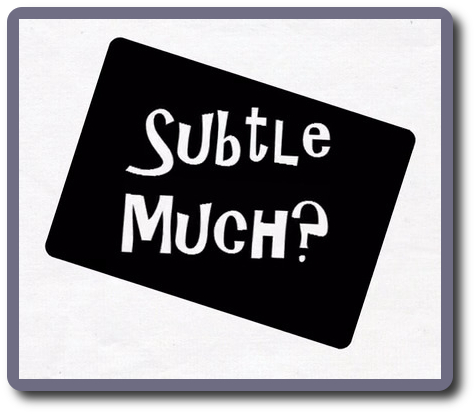
The Basics:
- For ages 8 and up (publisher suggests 15+)
- For 3 or more players
- Variable game play length
Geek Skills:
- Active Listening & Communication
- Counting & Math
- Logical & Critical Decision Making
- Reading
- Imagination
Learning Curve:
- Child – Easy
- Adult – Easy
Theme & Narrative:
- The ultimate game within the game
Endorsements:
- Gamer Geek mixed!
- Parent Geek approved!
- Child Geek mixed!
Overview
American singer, songwriter, and actress, Lauryn Hill, said “Reality is easy. It’s deception that’s the hard work.” In this metagame, players will be attempting to subtly achieve objectives without drawing attention to themselves. All the while, the players will also be expected to play the main game that is nothing more than a facade to cover the “real game” boiling below the surface.
Subtle Much?, published by Moresome Games, is comprised of 90 cards. The cards are as thick and as durable as your standard playing card. What little artwork there is on each card is subdued and placed in the background, looking more like an afterthought than as part of the original design. Regardless, the minimal approach works and works well.
That’s So Meta
Subtle Much? is a game you play while playing any other game you can imagine. It need not be another board game. It could be a video game or even watching a movie. The goal of Subtle Much? is to complete as many objectives, as described on the cards, as possible without drawing attention to yourself. This requires the player to be as subtle as possible, using deceptive ploys and a great deal of creative thinking to sneakily get their opponents to work with them.
Which is not easy, especially when everyone is expecting it.
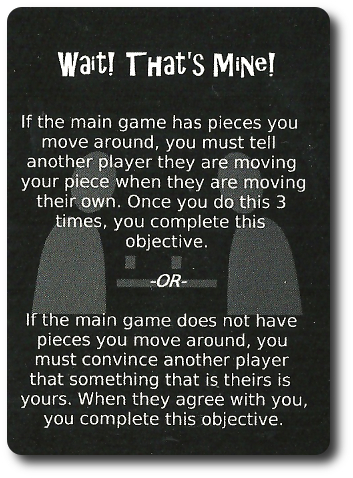
Subtle Much? is suggested for 3 or more players, but playing with as few as 2 players is also possible, albeit exceedingly difficult. To begin, get out whatever game you plan on playing and set it up as you normally would. This is the “main game”. Before playing the game, shuffle the Subtle Much? cards and deal 1 to each player, face-down. This is the player’s first objective. Objectives should always be kept secret until they are revealed. Place the remaining cards face-down next to the game and within easy reach of all the players. This is the Subtle Much? draw deck.
A Game Within a Game
Subtle Much? is played at the same time as the main game. The player’s card describes their objective that they must attempt to complete without their opponents knowing they are doing so. There are no rules regulating how a player should or should not go about attempting their objective. That is a puzzle for the player to solve within the context of the main game they are playing.
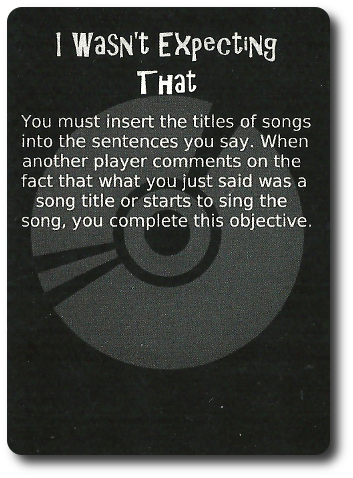
The player’s opponents can accuse them of being less than subtle and summarize their objective. If the opponent is correct, the player gives their card to their opponent who claims it for 1 point, placing it in their score pile. A summary of an objective need not be exact, but it must be close enough to get the gist of what the player is attempting. That is to say, it cannot be too general or generic. Then the player draws a new card for a new objective.
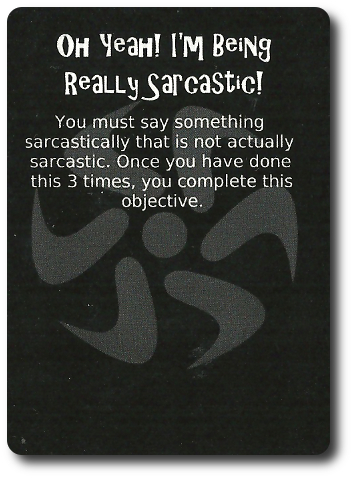
If a player is accused 3 times incorrectly, meaning the player’s opponents do not summarize the player’s objective well enough to suggest they know what the objective is, the player automatically scores their objective, placing it in their draw pile. However, if the player has not even attempted the objective, an opponent can accuse them of not doing so and collect the card for a point. Either way, the player then draws a new card.
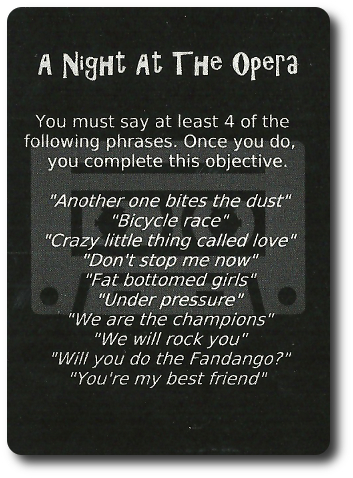
When a player correctly completes their objective, they should silently count to 5 in their head, giving their opponents an opportunity to challenge them. If no opponent does, the player reveals their card and collects it for 1 point, placing it in their score pile. If an opponent does correctly accuse before the 5 seconds are passed, the player loses their card. Either way, they then draw a new card.
This continues until the main game ends.
The Subtle Art of Not Being Subtle
When the main game ends, the players do not determine who won as normal. Instead, they count the number of collected Subtle Much? cards they have in their score pile. The player with the most cards wins Subtle Much? The winner of a tie is determined by the player with the fewest collected cards.
House Rules
Many of our players didn’t like the fact that winning the main game didn’t result in a victory (which might be a misinterpretation of the rules on our part). In order to make up for this, most of our players adopted a house rule that said you could not win the Subtle Much? unless you also won the main game. This means that players had to work as hard as they could to win the main game and the metagame.
To learn more about Subtle Much?, visit the game publisher’s website or visit the Kickstarter campaign.
Final Word
The Child Geeks had difficulty focusing on the main game and Subtle Much?, making it obvious at times when they were attempting to pull one over on their opponents. Hilariously, the teachers of the game had to keep reminding the Child Geeks to avoid looking at their cards BEFORE attempting to fulfill their objective. According to one Child Geek, “I like the way you play a game while playing another game, but I don’t think I’d want to play it with another game I really like.” Which is to say, this particular Child Geek found Subtle Much? to be a distraction, pulling his attention away from the main game he really wanted to play. Another Child Geek said, “I would play crappy board games again if we could play this at the same time.” Which, I think, is right on the money. While one Child Geek said Subtle Much? was a disruption, another is suggesting it’s a lifesaver, injecting energy in some games that were of little interest. When the votes were in, all of the Child Geeks liked what Subtle Much? was about, but were uncertain how often they would play with it, resulting in a mixed level of approval.
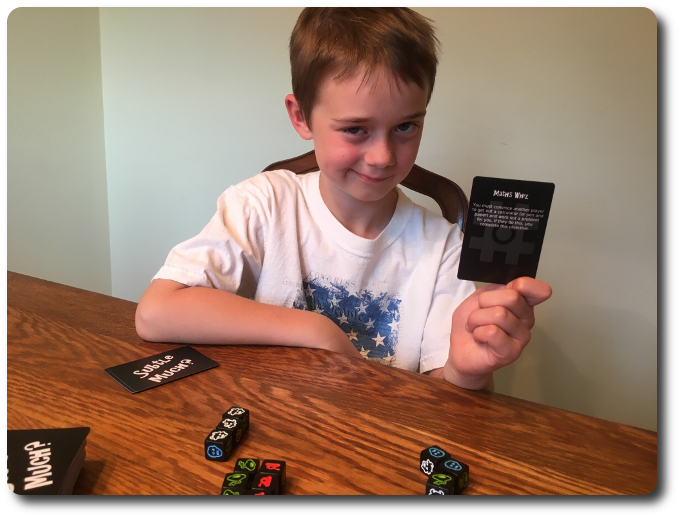
My son reveals he just completed his 3rd objective – his smirk was well-earned
The Parent Geeks very much enjoyed the game’s subtle plays and the way it almost seamless incorporated into their games. Emphasis here on “almost”. According to one Parent Geek, “It’s a bit odd, isn’t it? Players have to play the main game to the best of their ability, but at the same time play the other game. It feels a bit like a conflict at times, but I guess that’s the game.” Indeed it is. Players are expected to juggle the main game and the metagame without dropping any balls. One Parent Geek said, “I really like this. I don’t think I’d ever play it with games I really enjoy, but I can see myself taking this out the next time someone says let’s play Monopoly!” When all the votes were in, the Parent Geeks approved Subtle Much?
The Gamer Geeks liked how the game fit into just about anything, but didn’t like that the main game was just there for show. According to one Gamer Geek, “Why would anyone fake 3 plus hours of game playing just to score a card?” Another Gamer Geek said, “In order for this to really work, there needs to be two winners. The first is the main game and the second is the metagame.” But that raised even more questions with the Gamer Geeks. For example, why bother to play either or both? What was the point to winning one game, but not really winning anything in the process? This puzzled the Gamer Geeks and they couldn’t decide if Subtle Much? was brilliant or was just faking it. As one Gamer Geek put it, “It all comes down to what game you are playing. I would only play this if I was going to play another game I didn’t like. But then I have to ask myself, why play the other game in the first place? Why not just play a game I enjoy?” The Gamer Geeks pondered and pondered and finally decided that Subtle Much? was good for what it was, but difficult to place in a general sense. This resulted in a mixed level of approval from the Gamer Geeks.
Subtle Much? adds a fun interactive layer to any game, and by “any”, I mean “any”. The publishers bragged that it worked with Settlers of Catan, Takenoko, Monopoly, Blackjack, video games, and at dinner parties (which is not even a game). We tried it with Martian Dice, Dakota, Belfort, Telestrations, and riding in the car across country. In all cases, Subtle Much? worked. The amount of time players had to attempt to win was determined by the event. Short board games gave players around 45 minutes while trekking across the state gave players up to 6 hours. In either case, the game played well, but the longer you have to play, the less chances a player takes. This adds a new dimension to the subtle nature of the game and the demand on the players to keep paying attention to their opponents.
I found Subtle Much? to be pretty clever. Even if the objective has NOTHING to do with the game, it still works. Some of the objectives are flat out easy with the right crowd, while others are not regardless of who you are playing with. It’s a good mix that keeps all players alert and engaged, not only with the game, but also with each other. I do agree that Subtle Much? can feel like a distraction, especially when the goal to victory has nothing to do with the main game, but that’s part of the fun. If players aren’t taking the main game seriously, they are clearly attempting to pull a fast one on their opponents. And thus, the players must balance the need to look engrossed in the main game, while really focusing on their objective. It is, as they say, the “game within the game”.
But there is a price to pay. Whatever game that’s played with Subtle Much? becomes unimportant. It’s the stage on which the metagame is played and little more. Players act upon this stage, pretending to be engaged in the main game, but are largely ignoring it. This will make some games very long, as none of the players are spending energy advancing the game play. While Subtle Much? could be played with just about any game under the sun, it really shouldn’t. Very simple games are best and ones that will come to an end regardless of what the players do or do not do. For longer games, setting a timer might even be necessary.
Finally, there is a small flaw to the game that can be easily taken advantage of. If a player is accused 3 times incorrectly, they are awarded the card for a point, but they must first have tried to complete their objective at least once before they can do so. This means a player can half-ass an attempt and then go out of their way to draw attention to themselves to force accusations using purposely misleading hints. Is the player cheating? By no means, but it does allow a player to throw the game off its intended course. The only recourse is to ignore the player, forcing them to attempt their objective in a legit matter. The problem is, the game is not really concerned about being legit. Anything goes and that means players who find this weak spot can make the metagame less than entertaining.
Is Subtle Much? the ultimate metagame? Perhaps and I’m inclined to agree with the Gamer Geeks that Subtle Much? is best for really bad games and not those that are genuinely worth playing. Such a statement is subjective, however, and I don’t see why Subtle Much? would ruin any game other than tarnishing the player’s preferred game playing experience. In which case, Subtle Much? should be avoided by those who like games the way they are. For those looking to add a new dimension to their old and new games, social gatherings, and just about anything else you can think of, then this might be the metagame you’ve been looking for.
This is a paid for review of the game’s final prototype. Although our time and focus was financially compensated, our words are our own. We’d need at least 10 million dollars before we started saying what other people wanted. Such is the statuesque and legendary integrity of Father Geek which cannot be bought except by those who own their own private islands and small countries.



